The United States Armed Forces are the military forces of the United States. The armed forces consist of six service branches: the Army, Marine Corps, Navy, Air Force, Space Force, and Coast Guard. All six armed services are among the eight uniformed services of the United States.

The M1 Abrams is a third-generation American main battle tank designed by Chrysler Defense and named for General Creighton Abrams. Conceived for modern armored ground warfare and now one of the heaviest tanks in service at nearly 73.6 short tons. It introduced several modern technologies to United States armored forces, including a multifuel turbine engine, sophisticated Chobham composite armor, a computer fire control system, separate ammunition storage in a blowout compartment, and NBC protection for crew safety. Initial models of the M1 were armed with a 105 mm M68 gun, while later variants feature a license-produced Rheinmetall 120 mm L/44 designated M256.
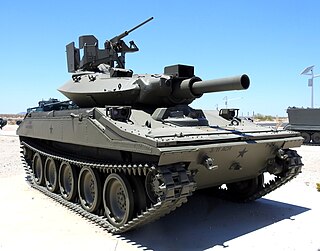
The M551 "Sheridan" AR/AAV was a light tank developed by the United States and named after General Philip Sheridan, of American Civil War fame. It was designed to be landed by parachute and to swim across rivers. It was armed with the technically advanced but troublesome M81/M81 Modified/M81E1 152 mm gun/launcher, which fired both conventional ammunition and the MGM-51 Shillelagh guided anti-tank missile.
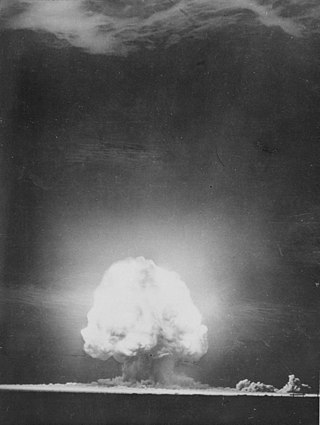
Technology played a significant role in World War II. Some of the technologies used during the war were developed during the interwar years of the 1920s and 1930s, much was developed in response to needs and lessons learned during the war, while others were beginning to be developed as the war ended. Many wars have had major effects on the technologies that we use in our daily lives, but World War II had the greatest effect on the technology and devices that are used today. Technology also played a greater role in the conduct of World War II than in any other war in history, and had a critical role in its outcome.

The Vietnam War involved the People's Army of Vietnam (PAVN) or North Vietnamese Army (NVA), National Liberation Front for South Vietnam (NLF) or Viet Cong (VC), and the armed forces of the People's Liberation Army (PLA), Army of the Republic of Vietnam (ARVN), United States Armed Forces, Republic of Korea Armed Forces, Armed Forces of the Philippines, Royal Thai Armed Forces, Australian Defence Force, and New Zealand Defence Force, with a variety of irregular troops.

Naval Air Station Fallon or NAS Fallon is the United States Navy's premier air-to-air and air-to-ground training facility. It is located southeast of the city of Fallon, east of Reno in western Nevada. Since 1996, it has been home to the U.S. Navy-Fighter Weapons School (TOPGUN) taking over from the former NAS Miramar, California, and the surrounding area contains 240,000 acres (97,000 ha) of bombing and electronic warfare ranges. It is also home to the Naval Aviation Warfighting Development Center (NAWDC), which includes TOPGUN, the Carrier Airborne Early Warning Weapons School (CAEWWS) and the Navy Rotary Wing Weapons School. Navy SEAL Combat Search and Rescue (CSAR) training also takes place there.
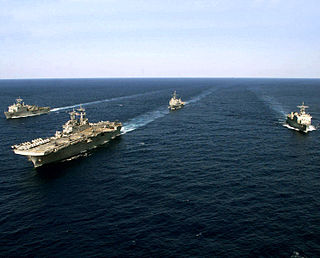
An amphibious ready group (ARG) of the United States Navy consists of a naval element—a group of warships known as an Amphibious Task Force (ATF)—and a landing force (LF) of U.S. Marines, in total about 5,000 people. Together, these elements and supporting units are trained, organized, and equipped to perform amphibious operations.

The Miramar Air Show is an annual air show held at Marine Corps Air Station Miramar in San Diego, California. The three-day event is the largest military air show in the United States, with total annual attendance estimated at 700,000. The show is held in October each year. The 2011 show was the 56th edition of the event, and celebrated the 100th anniversary of naval aviation. In 2007, the Miramar Air Show was voted the "World's Best Military Air Show" by the International Council of Air Shows, the first time the award was given to a Marine Corps air station since 1994.

An aggressor squadron or adversary squadron is a squadron that is trained to act as an opposing force in military wargames. Aggressor squadrons use enemy tactics, techniques, and procedures to give a realistic simulation of air combat. Since it is impractical to use actual enemy aircraft and equipment, surrogate aircraft are used to emulate potential adversaries.
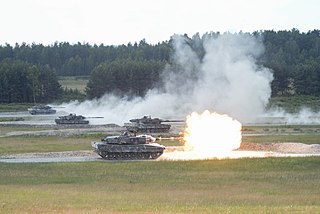
Armoured warfare or armored warfare, is the use of armoured fighting vehicles in modern warfare. It is a major component of modern methods of war. The premise of armoured warfare rests on the ability of troops to penetrate conventional defensive lines through use of manoeuvre by armoured units.

The Republic of China Army (ROCA), also known as the ROC Army and unofficially as the Taiwanese Army, is the largest branch of the Republic of China Armed Forces. An estimated 80% of the ROC Army is located on Taiwan, while the remainder are stationed on the Penghu, Kinmen, Matsu, Dongsha and Taiping Islands.
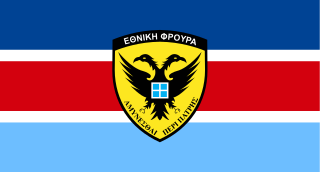
The National Guard of Cyprus, also known as the Greek Cypriot National Guard or simply National Guard, is the military force of the Republic of Cyprus. This force consists of air, land, sea and special forces elements, and is highly integrated with its first and second line reserves, as well as supporting civilian agencies and paramilitary forces.

The Naval Air Systems Command (NAVAIR) provides materiel support for aircraft and airborne weapon systems for the United States Navy. It is one of the Echelon II Navy systems commands (SYSCOM), and was established in 1966 as the successor to the Navy's Bureau of Naval Weapons.
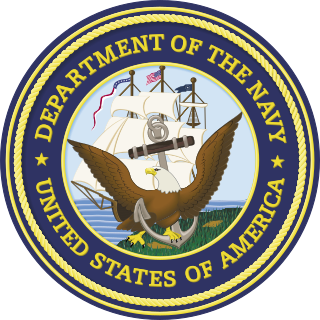
The Naval Air Warfare Center Training Systems Division (NAWCTSD) is an Echelon IV command of the United States Navy, reporting to the Commander, Naval Air Warfare Center - Aircraft Division (NAWCAD) at NAS Patuxent River, Maryland. NAWCTSD is located in Orlando, Florida in the Central Florida Research Park, adjacent to the University of Central Florida (UCF). The facility is a part of a larger military installation within the Central Florida Research Park known as Naval Support Activity Orlando.

Naval Air Station Key West, is a naval air station and military airport located on Boca Chica Key, four miles (6 km) east of the central business district of Key West, Florida, United States.

The United States Navy (USN) is the maritime service branch of the United States Armed Forces and one of the eight uniformed services of the United States. It is the world's most powerful navy and the largest by tonnage, at 4.5 million tons in 2021 and in 2009 an estimated battle fleet tonnage that exceeded the next 13 navies combined. It has the world's largest aircraft carrier fleet, with 11 in service, 1 undergoing trials, two new carriers under construction, and six other carriers planned as of 2024. With 336,978 personnel on active duty and 101,583 in the Ready Reserve, the U.S. Navy is the third largest of the United States military service branches in terms of personnel. It has 299 deployable combat vessels and about 4,012 operational aircraft as of July 18, 2023.

Forces goal 2030 is a military modernization program which began in 2009 and was revised in 2017. It was designed to enhance the capabilities of three service branches of Bangladesh Armed Forces: the Army, the Navy and the Air Force. The primary focus of the modernization program is the reformation of the military organization, expansion of the forces, the transformation of the indigenous defense sector to support research and manufacturing, and acquisition of modern military weapons. The requirement for modernization was realized in the aftermath of 2008 Bangladesh–Myanmar naval standoff later resulting in Bangladesh's favour. One of the primary objectives of the modernization program is to develop a three-dimensional force capable of conducting multi-platform warfare.



















